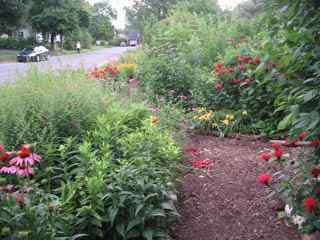|
July Habitat Garden Tours
Free and open to the public. Join us!
Show Me, Help Me Tour - Sun. July 26 at 1:00 pm A Wild Ones tradition! A Show Me Help tour points out
the many accomplishments of a homeowner (the Show Me part) as well
as providing tips for next steps (the Help Me part). This tour will be facilitated by Dan Carroll,
an expert natural landscaper. Tour visitors are also
welcome to make suggestions. Please RSVP to hg.cny@verizon.net so we have a rough idea of how many will be
attending. Directions to Ronda's garden...Homeowner Tours - You can arrange with some of
our HGCNYers to tour their gardens at a mutually agreeable time. (See meetings webpage for contact info...)Janet's Habitat Garden -  Sat. July 11 between 10:00 and 11:30 am Mon. July 13 between 6:30 and 8:00 pm Tues. July 21 between 6:30 and 8:00 pm Wed. July 29 between 6:30 and 8:00 pm (Directions to the Allens' gardens...) |
|
Featured plant: Joe-pye ... weed?  Joe-pye weed (Eupatorium, now renamed as Eutrochium), is a handsome plant that doesn't deserve its common name of "weed." There are a number of different species of joe-pye native to our region, but all are top nectar plants that attract many butterflies and bees.
Joe-pye weed (Eupatorium, now renamed as Eutrochium), is a handsome plant that doesn't deserve its common name of "weed." There are a number of different species of joe-pye native to our region, but all are top nectar plants that attract many butterflies and bees.
Joe-pye is easy to grow - you probably have seen it even growing wild in ditches. It thrives in moist areas, but most people find it also grows well in ordinary garden soil in sun or partial sun.
Except for some shorter cultivars, joe-pye is a tall plant growing up to 6 feet tall. It's spectacular in the back of the border, but if you want it closer to the front to better view the butterflies and the beautiful flowers, you can prune it early in the season. It will delay its flowering but will keep it shorter.
Joe-pye spreads by seed, so you'll see a few volunteers pop up, but they're easy to pull or give to fellow gardeners. All in all, a very worthy habitat plant!
|

Bad news for our ash trees
The emerald ash borer (EAB) has arrived in NYS.
The NY Forest Health Advisory Council makes the following recommendations:
* We must all work together to "Slow the Spread" of the EAB to buy time to find a solution.
* DO NOT MOVE FIREWOOD! This is the most common method of long-distance spread.
*
Early detection and rapid response are key elements to slowing the
spread and minimizing the impact of EAB. Be aware of the signs and
symptoms of EAB for early detection. And as for other invasive plants and animals, be sure you don't confuse them with our own look-alike natives. For more detailed info...
EAB can cause great ecological and economic harm. The scope of this
problem could reach the billions of dollars nationwide if not dealt
with since ash is a common timber species and is frequently planted as street trees.
|
|
Turf War
Americans can't live without their lawns-but how long can they live with them?
Excerpt from an article by Elizabeth Kolbert
in the July 21, 2008 issue of The New Yorker
Right around the time that Carson was writing "Silent Spring,"
Lorrie Otto, a mother of two from the Milwaukee suburb of Bayside,
decided to restore her front lawn to prairie. One day, while she was
folding laundry in her basement, some village workers arrived and,
without consulting her, mowed her yard. Otto began speaking out against
lawns, calling them, among other things, "sterile," "monotonous," and
"flagrantly wasteful." Her talks inspired the founding, in 1979, of
what might be described as the nation's first grassroots anti-grass
movement, which dubbed itself Wild Ones. (Wild Ones now has chapters in
twelve states, including New York and Connecticut.)
Between them, Carson and Otto introduced all the main anti-lawn
arguments: toxicity, habitat destruction, resource depletion, enforced
conformity. They accepted the moral interpretation of the lawn, only to
perform yet another inversion. Instead of demonstrating that a
homeowner cared about his neighbors, a trim and tidy stretch of turf
showed that he didn't.
"If they're so large that you cannot use just a little hand-push
lawn mower, then I truly think they are evil," Otto once said of lawns.
"Really evil."
To read Kolbert's entire article...
|
|
Wildlife Gardeners Forum
One of our members passed along the Wildlife Gardeners Forum, which she finds to be a good source of sharing information about various aspects of wildlife gardening. |
|
Save some room in your yard...
From Project Laundry List:
About 5.8% of residential electricity use goes towards the clothes dryer, according to Dept. of Energy statistics from 2001. And this doesn't take into account people who do their wash at laundromats or whose laundry is done at institutions. Additional energy is consumed if you include those who use gas dryers.
 Unlike most other types of appliances, electric clothes dryers don't vary much
in the amount of energy used from model to model. Unlike most other types of appliances, electric clothes dryers don't vary much
in the amount of energy used from model to model.
Enter the solar clothes dryer!
If all Americans would use the clothesline or wooden drying racks, the
savings would be enough to close several power plants. So save some room in your habitat garden to sprout some energy savings and prevent CO2 emissions.
|